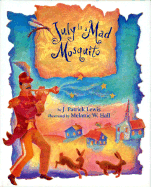Readers Guide created by Cate Marshall
Lewis, J. Patrick. 1994. July is a Mad Mosquito. New York: Anthenum. ISBN: 0-689-31813-8
Lewis, J. Patrick. 1994. July is a Mad Mosquito. New York: Anthenum. ISBN: 0-689-31813-8
Recommended age: 6-10
Summary of book:
J. Patrick Lewis creates a theme for each month in his book JULY IS A MAD MOSQUITO. Beginning with the chills of January, he rhymes about famed Punxsutawney Phil, April showers, summer bugs and sun, and the winter blues. Each month's page reminds the reader of the joys of that time of year, invoking the sights, smells, sounds and holidays we encounter throughout its days. The collection of monthly poems is ended with a fun poem about all the months, naming an animal (or bug!) that represents each. Lewis' rhymes are accompanied by Hall's beautiful illustrations, her color choices bring to life the imagery found in his words.
Review excerpts for the book:
Booklist: “Appearing with the poems on double-page spreads are Hall's lively illustrations, fanciful scenes in popsicle-bright pastels and muted blues and browns. No fireworks here, but a few sparklers, enough to justify purchase for large poetry collections.”
Bulletin of the Center for Children's Books: “The rhythms are catchy and the imagery ever-crisp, from 'January' ('Great days of ice!/ Refrigerated/ Paradise') through 'December' ('Two carolers on the green,/ Who just became a trio/ With my snowman in between'). Hall's pictures dance right along with the verses, which convey surprising sounds in formal meters. You've got twelve story-hour starters right here, and the collection as a whole would also make a nicely unpedantic introduction to the shifting seasons; in any case, the poems are fun to read aloud.”
School Library Journal: “Lewis's sensitive and imaginative voice is a welcome addition to the literature. A full-color, double-spread impressionistic painting interprets the activity in each poem, while a six-stanza verse summaries the entire year. An enjoyable volume that should enliven and enhance most poetry collections.”
Kirkus Reviews: “A baker's dozen of lightly lyrical poems in a cycle of months summed up in a final entry: “January's a polar bear;/February's a mole....'' Though he offers few epiphanies, Lewis's descriptions are vivid, his images are fresh and appealing, and he makes deft use of a variety of rhyme schemes and verse forms, including a lovely haiku for August: ``At bedtime, outside/my room...nighthawk and trainsong/on the wind's guitar.'' Hall's stylized art, in a rainbow of yummy hues as bright as Italian ices, makes this useful offering especially attractive."
Questions to ask before reading:
What particular sights, smells, or objects do you associate with each month?
Do you think that children all over the world associate the same sights, smells, and objects with the same months like we do?
What is your favorite month of the year, and why?
How can poems make us feel things? What elements of books like this carry the most impact when it comes to grabbing your senses?
Suggestions for reading poems aloud:
Pick a poem (month) for each day of class, design a workshop based around each month. Have different students assigned to each month and have them read the poem aloud to the class and even bring props to go with each month's theme.
Have each student bring something that signifies a month of the year for them, for instance someone could bring cotton candy to signify a summer month, or someone could bring a snowflake to signify January.
Split the students into groups based on their birth month and have them present their poem to the class as well as bring/discuss a few items that Lewis does not mention that remind them of that month.
Re-type the poems (without the month titles) and split the students into groups, each group has all of the poems and must figure out which month they are written for just by reading the poem.
Follow up activities:
Art: Have each student make a calendar for the book, using their own artistic abilities (painting, drawing, collage, etc) to illustrate each month. Students can include cut-outs of the poem in the illustrations, or can find other ways to bring Lewis' themes into their work.
Social Studies: Discuss seasons around the world and how our ideas of winter in January may not be the same as China's January (it would be hot, not cold!). Let students pick an area of the world and have them list a few descriptors or images that would signify that particular month for that area of the world.
Writing: Have the students write their own poem for their birth month. Encourage them to use demonstrate their favorite things about that particular month.
Art/Social Studies: Assign a few students to each month and have them put together a project where they dress appropriately for their month and bring a food item and an item of their choice to represent the month and present to the class.
Related websites/blogs:
J. Patrick Lewis's home page: http://www.jpatricklewis.com/
Poetry Foundation for those interested in more poetry resources: http://www.poetryfoundation.org/
Some day and month learning activities for young children: http://www.earlylearningactivities.com/PDF/daysmonths.pdf
Fun activities based around poetry: http://adifferentplace.org/poetry.htm
A teacher's guide for poetry: http://www.theteachersguide.com/poetrymonth.htm
Related books:
Other Poetry by J. Patrick Lewis:
Lewis, J. Patrick. 1994. The Fat-Cats At Sea. Knopf.
Lewis, J. Patrick. 1998. The House of Boo. Simon & Schuster/Atheneum.
Lewis, J. Patrick. 1998. Boshblobberbosh; Runcible Poems for Edward Lear. Mankato: Creative Editions; San Diego: Harcourt.
Other poetry about the months:
Bunting, Eve. 2002. Sing a Song of Piglets. Clarion Books.
Dragonwagon, Crescent. 1993. Alligators and others all year long!. Macmillan.

No comments:
Post a Comment